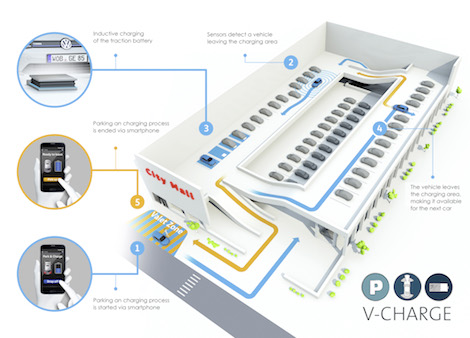Here's an interesting one - Volkswagen is working with a number of German and international partners to create a fully automated parking service for electric vehicles, which not only inductively charges the car's battery but also ensures the car vacates a charging bay as soon as it's full of battery power, whether the owner has returned to it or not.
Sounds complex, huh? But in fact, with cars already parking themselves in a limited fashion (either with on-board park assist tech initiated by humans, or the more advanced systems seen on the new BMW 7 Series/Mercedes E-Class in which the car can be remotely parked using a phone app), and the self-driving car no longer the preserve of science fiction films, V-Charge - Volkswagen's name for Valet Charge parking - might not be as far-fetched as it at first sounds.
V-Charge works like this. In defined zones, such as multi-storey car parks, the driver pulls up to a pre-defined drop-off/pick-up zone outside the parking area. Using a smartphone app, the driver can then establish a link with the car and tell it to go and find a space.
A digital map of the parking area is relayed to the car's on-board software and off it goes, merrily toddling away to find a space all on its own - with no human inside. While the autonomous valet parking part of it could naturally work with non-electric cars (whereby it simply finds the first available space, parks there and then returns to the pick-up point when its driver summons it later in the day), for electric vehicles the car will prioritise parking bays with inductive charging and navigate to those first.
But instead of staying in them all day, once the battery is full the car automatically starts itself again and moves off to a non-charging parking bay, thus freeing up the charging point for another electric car user to enjoy.
Ah, we hear you say, but can the autonomous car recognise other traffic in the car park? And the answer is: yes. Of course it can. This is a German company we're talking about, at the end of the day. Pedestrians, cyclists and other vehicles are identified by cameras and ultrasound sensors integrated within the car, so it can travel safely in 'mixed traffic'.
The following groups are working with Volkswagen on this project: the Swiss Federal Institute of Technology in Zurich (visual localisation, movement planning and vehicle control); Braunschweig Technical University (car park management and vehicle-to-infrastructure - V2I - communication); Bosch (sensor technology); Parma University (object recognition); and Oxford University (development of detailed navigation maps of the parking areas).
Anything else?
Want to see how this all works? Are you an angry valet parker who fears for their career? Then watch the autonomous Golf V-Charge prototype in action right here.


